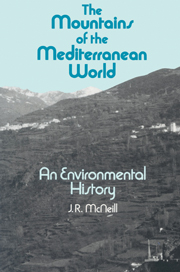Book contents
- Frontmatter
- Contents
- List of Illustrations and Tables
- Preface
- Note on Transliteration
- List of Abbreviations
- 1 The Argument: Ecology, Economy, Shells, and Skeletons
- 2 Mediterranean Mountain Environments
- 3 The Deep History of Mediterranean Landscapes
- 4 Material Life in the Mountain Environment, 1700–1900
- 5 Population, Settlement, and Landscapes
- 6 Political Economy and Mountain Landscapes
- 7 The Changing Landscape since 1800
- 8 Conclusion
- Bibliography
- Index
7 - The Changing Landscape since 1800
Published online by Cambridge University Press: 29 September 2009
- Frontmatter
- Contents
- List of Illustrations and Tables
- Preface
- Note on Transliteration
- List of Abbreviations
- 1 The Argument: Ecology, Economy, Shells, and Skeletons
- 2 Mediterranean Mountain Environments
- 3 The Deep History of Mediterranean Landscapes
- 4 Material Life in the Mountain Environment, 1700–1900
- 5 Population, Settlement, and Landscapes
- 6 Political Economy and Mountain Landscapes
- 7 The Changing Landscape since 1800
- 8 Conclusion
- Bibliography
- Index
Summary
The upland landscapes of the Mediterranean are not in line with their geomorphologic situation. Bare rocks obtrude where they do not belong.
Carl Sauer (1963, 146)Find me a new religion – a religion of which the chief rite is tree planting.
Mustafa Kemal AtatürkConcentrated demand corroded many mountain landscapes from the eighteenth century on. The mountain way of life endangered many more by its cumulative effect over the centuries. It is well to summarize the range of potential effects of the local economy upon mountain ecology before evaluating the evidence of ecological change.
Economy and Landscapes
Agriculture
Of the economic activities in the mountains of the Mediterranean, agriculture, pastoralism, logging, and fuelwood gathering had the strongest impacts on the land. In the peasant massifs – the Rif, the Sierra Nevada, the Apennines, and, after 1600 or so, the Pindus – agriculture lay at the heart of economic life. Cultivation destabilized mountainsides more completely than any other human activity. This is so in part because people practiced it far and wide, but chiefly because it required full substitution of existing plant cover. In the earliest stages of that substitution – land clearing – topsoils and humus long protected from wind and rain suddenly became exposed and vulnerable. Land clearing always involved accelerated erosion. Its rapidity varied with slopes, soil mechanics, and much else. In the Mediterranean, cultivators normally cleared new land in the late summer, when parched vegetation burned most easily.
- Type
- Chapter
- Information
- The Mountains of the Mediterranean World , pp. 272 - 350Publisher: Cambridge University PressPrint publication year: 1992



